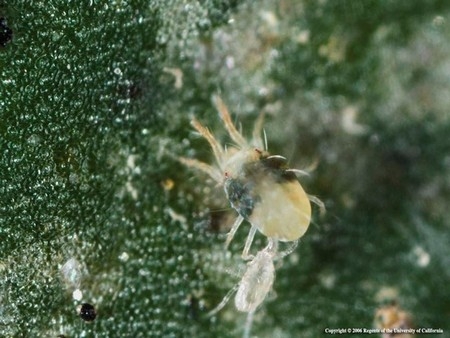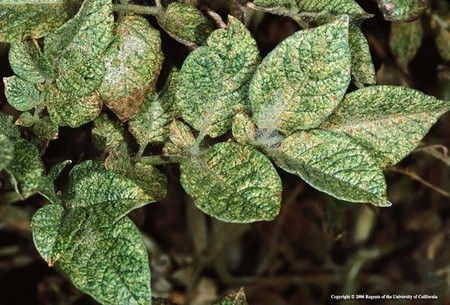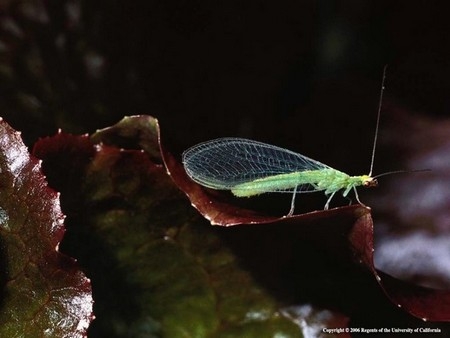- Author: Help Desk Team
Spider mites are very common pests found on many of our landscape and vegetable garden plants. They are tiny and difficult to see but once you learn about them, you might start seeing evidence of infestation on a wide variety of plants.
Spider mites live in colonies, mostly on the back side of leaves. They are less than 1/20 of an inch long, have eight legs, and if you look carefully, you can see two red eyespots. When their population is high, you might see dense webbing covering the leaves, twigs, or fruit.
Spider mites use piercing mouthparts to suck cell contents from leaves. Damage appears first as a stippling of light dots on the top of the leaves. Evidence of their presence can be seen or felt on some leaves—fecal matter, cast off exoskeletons of young mites, dead mites, and fine webbing becomes more obvious with heavy infestations. With heavier infestations, leaves can turn yellow and fall off.
Spider mite activity is most severe and damaging during hot, dusty conditions, and when plants are water-stressed. June through October are prime months for these little pests. In Contra Costa's relatively mild climate, spider mites can feed and reproduce year-round on evergreen plants. On deciduous plants, they can spend the winter under rough bark or on the ground.
To control spider mites, make sure your plants are not drought stressed. Dusty conditions often encourage spider mite outbreaks. Regular, forceful spraying of your plants with water, especially the undersides of the leaves, will often reduce their numbers and the damage they do.
Spider mites have many natural enemies that help control them, including lacewings, predatory thrips, and predatory mites. Maintaining a diverse garden habitat can encourage these predatory mites and insects to stay in your garden, waiting to assist with pest control.
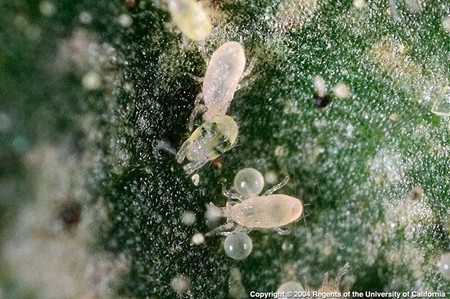
If more control is needed, consider using an insecticidal soap or an insecticidal oil such as Neem oil in your sprayer and make sure you spray enough to fully cover both tops and bottoms of leaves. You'll need to spray soap again two or three days later to cover any newly hatched spider mites, because soap doesn't have residual action.
If you choose to spray insecticidal soap or insecticidal oil, don't spray if temperatures are over 90 degrees F and make sure to follow the label instructions. Before spraying it on the whole plant, test it on a few leaves to make sure it doesn't damage them. Using broad spectrum insecticides is not recommended as these can kill the natural enemies of spider mites, which may result in an increase in the spider mite population
How to prevent spider mites
Scout plants for their presence anytime hot and dry conditions occur. If you catch spider mites early, you may be able to prevent a large infestation just by removing a part of a plant or a single plant. Watering down dusty walkways and misting plants when it's hot and dry can make it less attractive to spider mites. If a plant becomes too infested and treatments are not working, consider removing that plant to reduce the chance of the spider mites traveling to other nearby plants.
For more information on managing spider mites, see this Pest Note: https://ipm.ucanr.edu/PMG/PESTNOTES/pn7405.html
Help Desk of the UC Master Gardeners of Contra Costa County (SEH)
Advice for the Home Gardener from the Help Desk of the
UC Master Gardener Program of Contra Costa County
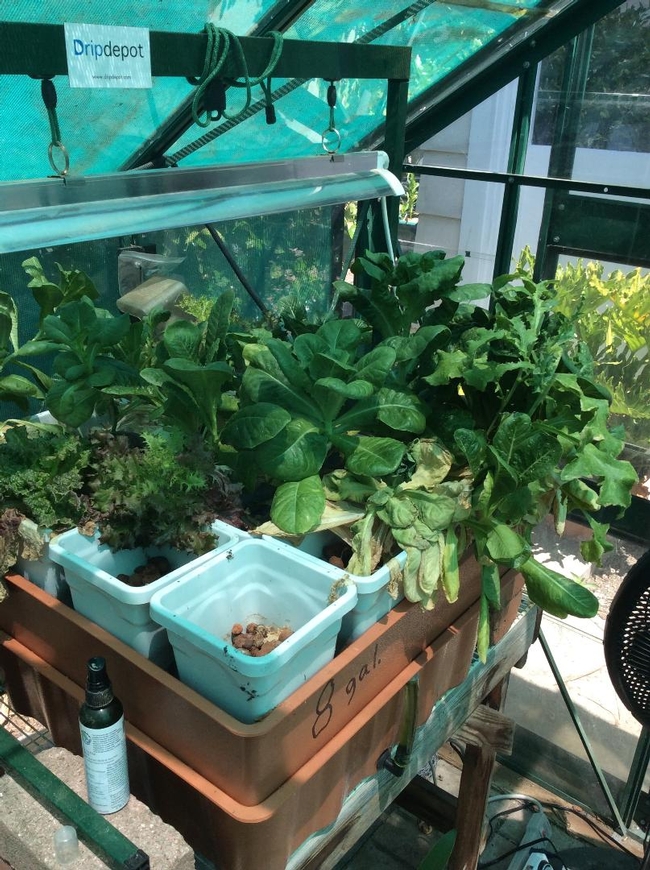
MGCC Help Desk Reesponse: Thank you for contacting the UC Master Gardener Program Help Desk for help with your spider mite problem.
During hot weather, spider mites reproduce very quickly. The University of California reports that in hot weather conditions the entire life cycle (from newly laid egg to an egg-laying adult) can occur in just a week. Since each female mite can lay thousands of eggs which take only a day or two to hatch when the weather is hot, the population can quickly go from being almost unnoticeable to a full-blown infestation.
One of the first defenses against spider mites are several different beneficial insects. It is quite possible that these natural enemies were not able to reach the mites inside your green house, allowing the population to explode without check.
Your photo shows some plants that have been badly attacked by the spider mites and others that still look healthy. Keep in mind that spider mites feed on many types of vegetables and ornamental plants as well as on fruit trees, vines and berries. So there is a good chance that the spider mites will spread to some of your other plants in the greenhouse and are probably also present elsewhere in your garden.
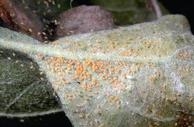
UCANR photo
Insecticides are not a good choice for controlling the spider mites. Not only will the insecticides kill any beneficial insects that might be present, the active ingredient in some types of insecticides have actually been found to accelerate the reproduction cycle of the spider mites.
Insecticidal soaps and oils can help control spider mites, but may not be a particularly good option for food crops like lettuces.
One approach that you might want to consider would be to purchase some beneficial predatory mites and release them in the greenhouse. The predatory mites feed on the spider mites. They don't feed on foliage and so they won't become pests for your plants. If the spider mite population is eliminated, the predatory mites could move to a new location, or might simply die off. If you do an internet search for “predatory mites”, you will find places to mail order the predatory mites.
Also, you should be aware that cultural practices can also affect spider mite populations. The populations seem to increase in dusty conditions and water stressed plants are particularly vulnerable to attack. Judging from your photo, dust and water stress are probably not factors for your spider mite problem inside the greenhouse, but it's good to keep these cultural considerations in mind should the spider mites move to your outdoor spaces.
You can find more information about the use of insecticidal soaps and predatory mites to control spider mites at this UC website: http://ipm.ucanr.edu/PMG/PESTNOTES/pn7405.html
We hope that this information is helpful. You're welcome to contact us again if you have additional questions.
Help Desk of the UC Master Gardener Program of Contra Costa County (TKL)
Note: The UC Master Gardeners Program of Contra Costa's Help Desk is available year-round to answer your gardening questions. Except for a few holidays, we're open every week, Monday through Thursday for walk-ins from 9:00 am to Noon at 75 Santa Barbara Road, 2d Floor, Pleasant Hill, CA 94523, although we will be moving late July. We will notify you when that occurs. We can also be reached via telephone: (925) 646-6586, email: ccmg@ucanr.edu, or on the web at http://ccmg.ucanr.edu/Ask_Us/ MGCC Blogs can be found at http://ccmg.ucanr.edu/HortCoCo/ You can also subscribe to the Biog (http://ucanr.edu/blogs/CCMGBlog/)


